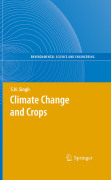
Climate change is directly linked to the human activities, according to the Fourth Assessment Report of IPCC (2007). In last two decades of 20th Century, accelerated anthropogenic activities pushed up the atmospheric abundance of greenhouse gases, mainly CO2, CH4, and N2O, alarmingly which enhanced the radiative forcing of the Earth’s surface and thus perturbed its heat radiation balance. As a consequence, atmospheric characteristics, such as temperature, rainfall pattern, levels of CO2 and O3 have changed significantly, affecting the farmproductivity. Although rising level of CO2 may have fertilizing affect on C3 crops, but concomitant rise in atmospheric temperature, O3 level and extreme weather conditions can not only nullify the fertilizing affect of CO2, but alsodrastically reduce the crop production, threatening food security to burgeoning world population. Compiles latest findings of studies carried out by the scientists on climate change and crops aroung the world INDICE: Crop Responses to Elevated Carbon Dioxide and Temperature.- Simulation Studies to Characterize the Impact of Climate Change on Crop Production and to Identify Strategies for Adaptation and Mitigation.- Greenhouse Gases from Crop Fields.- Impacts of Ground-level Ozone on Crop Production in a ChangingClimate.- Physiological Responses of Higher Plants to UV-B Radiation.- Attenuating Methane Emission from Paddy fields.
- ISBN: 978-3-540-88245-9
- Editorial: Springer
- Encuadernacion: Cartoné
- Páginas: 550
- Fecha Publicación: 01/02/2009
- Nº Volúmenes: 1
- Idioma: Inglés
